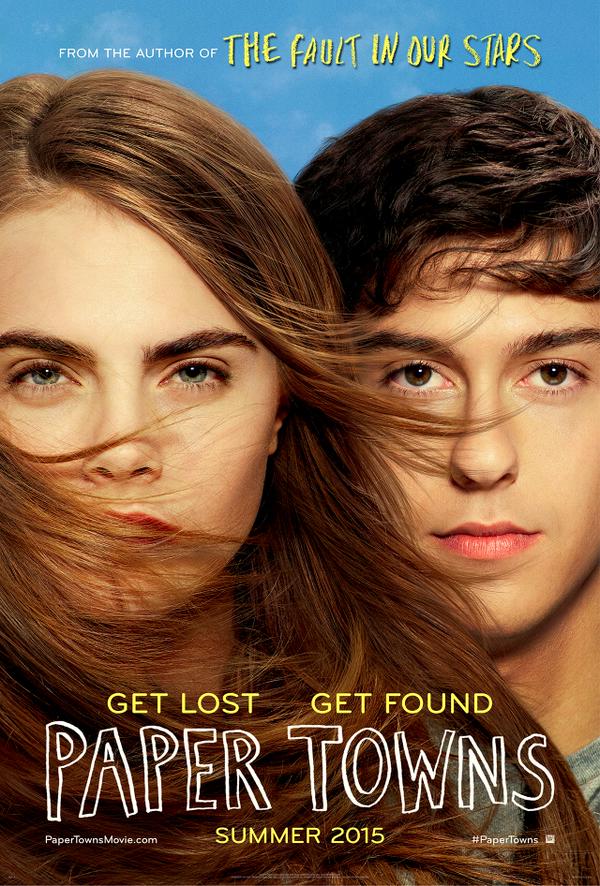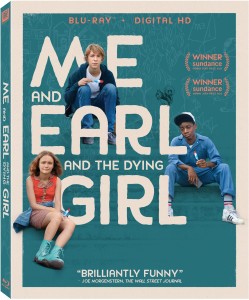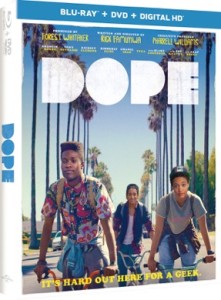This summer saw the release of three new coming of age films driven by stories about young men on the cusp of adulthood. Paper Towns, Me and Earl and the Dying Girl and Dope all feature high school seniors who experience life changing events that redefine who they are before graduating. In a genre dominated by teenage girls, it’s refreshing to have some movies about the male experience, especially since so many YA films are influenced by John Hughes and Cameron Crowe, two filmmakers whose finest work gave equal time to both sexes.
 Paper Towns is based on the novel of the same name by the reigning king of YA, John Green. You may know his name because he wrote The Fault in Our Stars, the blockbuster novel that became a blockbuster film. The success of that movie lead 20th Century Fox to hire its screenwriters, Scott Neustadter and Michael Weber, to adapt Green’s Paper Towns into a film. Paper Towns doesn’t have the weight of Fault. No one is has cancer; there are no life and death situations. Its execution and tone will feel very familiar to anyone who’s ever seen a teen film in the last thirty years.
Paper Towns is based on the novel of the same name by the reigning king of YA, John Green. You may know his name because he wrote The Fault in Our Stars, the blockbuster novel that became a blockbuster film. The success of that movie lead 20th Century Fox to hire its screenwriters, Scott Neustadter and Michael Weber, to adapt Green’s Paper Towns into a film. Paper Towns doesn’t have the weight of Fault. No one is has cancer; there are no life and death situations. Its execution and tone will feel very familiar to anyone who’s ever seen a teen film in the last thirty years.
The endearing Nat Wolff (who also had a significant role in Fault) stars as Quentin ”Q” Jacobsen, a straight-A, straight laced band geek who’s pined for the enigmatic Margo Roth Spiegelman (Cara Delevingne), ever since she moved in across the street when he was a boy. As children, Q and Margo were inseparable and would explore their hometown, a suburb of Orlando, FLA. One afternoon, they discovered the dead body of a man in a local park. The event had a profound effect on Margo and she began questioning life and running away from home.
As high school teens, Q and Margo grew apart and fell in with different cliques. Margo seemed to settle down and became one of the most popular girls in school, dating a top jock. Meanwhile, Q became friends with fellow bandmates Ben (the delightful Austin Adams), a sex-hungry goofball, and Radar (Justice Smith), a thoughtful, sensible voice of reason.
With the end of high school approaching, Q reflects on his carefree childhood, times when Margo would appear in his window and they would escape into the city. After the brief prologue about their relationship, Margo appears one last time to set the story’s plot in motion. She wants Q’s help in pulling off two elaborate pranks. Having discovered that her boyfriend cheated on her with one of her best friends and Margo wants revenge. She and Q spend the night carrying out her plans and end the night slow dancing in a high rise overlooking Orlando. He almost tells he loves her, but hesitates. The next morning, Margo has disappeared.
Days pass and no one hears from her. Margo’s uncaring parents won’t list her as missing with the police. Her mother scowls and states that Margo doesn’t want to be found, therefore she isn’t missing. They’re done with her. But Q can’t write off Margo. When he begins finding clues she’s left behind, he accepts the challenge of tracking her down. What follows is Q and his best friends uncovering what happened to Margo and Q hoping he has the courage to tell her his true feelings.
Paper Towns was directed by Jake Schreier, who also directed the critically acclaimed Robot and Frank. Schreier doesn’t do anything breathtakingly visual in Paper Towns, instead he stays out of the way of his nice cast and keeps the action moving forward. He handles the emotional scenes with a tender touch, and knows how to direct a comic scene. Wolff and the rest of the cast, which also include Halston Sage and Jaz Sinclair, are strong, especially Adams. Weakest among them is Delevingne, who doesn’t create enough mystery about Margo mysterious to make her truly interesting to me. Moreover, I never truly believed she could be the super popular girl or the rebel rouser she’s supposed to be.
The biggest disappointment is the script. Neustadter and Weber do a serviceable job, but there’s nothing significant about what they have the characters saying. Teenagers will love Paper Towns, I’m sure, but I don’t think there’s quite enough substance to keep the grownups interested. For a film like that, I suggest our next movie.
Remember the name Alfonso Gomez-Rejon, because he is one of the next great filmmakers of  this generation. After years of outstanding television directing (most notable his defining work on American Horror Story) and one stylish horror movie (The Town that Dreaded Sundown), Gomez-Rejon tackles the heart wrenching subject matter of teenage cancer in Me and Earl and the Dying Girl. Before you dismiss me and say, ”Weren’t we just talking about The Fault in Our Stars,” I implore you watch this deeply personal film that is both a celebration of life and movies.
this generation. After years of outstanding television directing (most notable his defining work on American Horror Story) and one stylish horror movie (The Town that Dreaded Sundown), Gomez-Rejon tackles the heart wrenching subject matter of teenage cancer in Me and Earl and the Dying Girl. Before you dismiss me and say, ”Weren’t we just talking about The Fault in Our Stars,” I implore you watch this deeply personal film that is both a celebration of life and movies.
Gomez-Rejon’s father passed away before the making of the movie. Both his love and grief for his father come through in every inspired frame of Me and Earl and the Dying Girl. The director is a protÁ©gÁ© of Martin Scorsese and the influence of his mentor is apparent from the opening moments. But like any good artist, Gomez-Rejon doesn’t mimic Scorsese; he takes what he learned and makes it his own. This film could have easily been a very straight forward teen comedy/tearjerker, with standard camera shots (establishing shot, medium, medium and close-ups) and manipulative editing. Instead, Me and Earl and the Dying Girl is a visual treat, thanks to the director’s keen eye and his collaboration with cinematographer, Chung-hoon Chung.
The film stars Thomas Mann as Greg Gaines, a high school senior who’s mastered the art of invisibility. He maintains friendly relationships with every clique in his school, but he doesn’t have any close friends. The person he spends most of his time with is Earl (RJ Cyler), a kid whose life is the complete opposite of Greg’s. Whereas Greg comes an affluent family with two loving parents (Nick Offerman and a perfect Connie Britton), Earl’s home is chaotic. His father is out of the picture, his mom is a recluse, and he has an older brother who hangs out on the porch smoking blunts.
The two met in kindergarten and bonded over the collection of foreign films belonging to Greg’s dad. As they got older, the boys began making their own movies, parodies of such classics like Peeping Tom, Midnight Cowboy, Mean Streets and The 400 Blows. The films are a private endeavor, not for public consumption. And Greg is such a weirdo that he doesn’t even consider Earl his friend, but his ”co-worker.”
Life for Greg changes when his mom forces him to visit Rachel Kushner (an exquisite Olivia Cooke), a classmate diagnosed with Leukemia. The two knew each other way back when, but since high school, well, we know how Greg relates to his peers in high school. Greg and Rachel connect on a dark, comical level. He’s brutally honest with her and she appreciates someone not fawning over her with sympathy eyes and well wishes.
As you would expect, the cynical friendship between the two teens develops into a deep and loving bond and Greg becomes the one person Rachel can rely on. While her mom (a wonderful Molly Shannon) mutes her anguish with wine, Greg visits her day in and day out. What was mandatory becomes something deeper for him, even though he refuses to admit it. Although Greg wants to remain removed from everything and hide behind his camera, being with Rachel forces him to shed his invisibility and become a part of the real world.
When Greg introduces Rachel to Earl, all walls come down, as Earl reveals the secret about their films and Rachel demands to see them.
Screenwriter Jesse Andrews adapted his own bestselling book for the film. Having read it, I believe he improved on the story vastly. Whereas Greg in the book starts to become annoying, the Greg in the film actually matures. Mann is a fine actor who is able to go deep into Greg’s character and express the humanity of his character. Olivia Cooke makes Rachel’s courage palpable, delivering one of the most gut wrenching performances I’ve seen this year.
In the end, though, it’s Gomez-Rejon who is responsible for the triumph of Me and Earl and the Dying Girl. He takes what could be standard YA tear jerker and makes it a work of art. Having followed his television career and witnessed the way he’s worked with some of the greatest talent in Hollywood (Jessica Lange, Kathy Bates, Sarah Paulson and Evan Peters, to name a few), I’m thrilled to see what he’ll do next.
 In Rick Famuyiwa’s infectious film, Dope, Malcolm (Shameik Moore), a self-proclaimed geek who dresses like he stepped out of the 90s and favors old school rap to the new beats. He and his two best friends, Jib (Tony Revolri of The Grand Budapest Hotel) and Diggy (Kiersey Clemons), cruise their section of Inglewood, CA they call ”the Bottoms” on their BMX bikes and spend their free time VHS copies of old Yo MTV Raps episodes and writing songs for their punk/ska band Awreeoh (pernounced Oreo). Well aware of the dangers that lurk around every corner (gangs over here, adrug dealers over there), Malcolm and his friends keep to themselves, get straight-A’s and stay out of trouble.
In Rick Famuyiwa’s infectious film, Dope, Malcolm (Shameik Moore), a self-proclaimed geek who dresses like he stepped out of the 90s and favors old school rap to the new beats. He and his two best friends, Jib (Tony Revolri of The Grand Budapest Hotel) and Diggy (Kiersey Clemons), cruise their section of Inglewood, CA they call ”the Bottoms” on their BMX bikes and spend their free time VHS copies of old Yo MTV Raps episodes and writing songs for their punk/ska band Awreeoh (pernounced Oreo). Well aware of the dangers that lurk around every corner (gangs over here, adrug dealers over there), Malcolm and his friends keep to themselves, get straight-A’s and stay out of trouble.
Malcolm lives with his mom, a bus driver, and is confident he’ll get into Harvard. But he’s cocky. Instead of writing a college essay about who he is and why he deserves to be admitted to an Ivy League school, Malcom chooses to write about the merits of Ice Cube’s ”It Was a Good Day.” Cinema hasn’t had a character like Malcolm in quite some time. He’s a one of a kind and you can’t help but root for this guy.
Fate intervenes in Malcolm’s life when he has a run-in with an intuitive drug dealer, Dom (rapper A$AP Rocky). Dom and Malcolm’s conversation about the golden age of rap is one of the highlights of the first act of Dope. A small favor for Dom introduces Malcolm to Nakia (Zoe Kravitz), a high school dropout working on her GED so she can go to college. Malcolm is immediately infatuated. When she invites him to Dom’s birthday party at a local club, the three best friends decide to attend, even though they’re under aged and out of their element.
Fumuyiwa combines the fun of adolescence with the danger of the Bottoms with ease. One minute, Jib and Diggy are drinking and grinding with girls on the dance floor, and moments later guns are drawn and shots are being fired. Just like someone living in Malcolm’s part of the world, you come to accept this schizophrenic reality. The night at a club and with a police raid, Dom’s arrest, and a stash of drugs and a gun getting slipped into Malcolm’s backpack. This leads to a series of misadventures that include rival drug dealers, wannabe hip hop artists, a flaky computer hacker (the hilarious Blake Anderson from Comedy Central’s Workaholics) and a brief drug enterprise using bitcoin.
The cast of Dope is remarkable. Moore, who has very few credits, is asked to carry the weight of the entire film on his shoulders. At no time does it feel like this kid is in over his head. Everything that Famuyiwa asks of him, from teenage innocence to hardened, pissed off youth, he does so like a seasoned vet. Toward the end, when Malcolm finally loses his shit, Moore doesn’t hit a false note. You’re right there with him the whole time, embedded in his pain and fear.
Revolori and Clemons are a fantastic in their respective roles. Each breathes so much life into their parts that I would love to see a movie about their home lives and their struggles. You don’t see anything of them beyond their interaction with Malcolm, so it’s a credit to Famuyiwa imbuing these characters with life, and the fine performances by the actors to make you know them so well, even though their screen time is limited to being sidekicks.
If you watch Dope closely, you’ll notice similarities to several classic teen comedies, including Risky Business and The Last American Virgin. Yet, writer/director Famuyiwa brings a freshness to his script that makes it stand above the many imitators of those films. He directs with an energy and enthusiasm that hauls you in and never lets up. Toward the end of watching Dope for the first time I was reminded of early Spike Lee movies, ones that mixed social commentary with comedy, pathos and wildly diverse characters. That’s what Famuyiwa has achieved.
Dope is a classic, deserving to be mentioned in the same pantheon as Almost Famous, The Breakfast Club and Stand by Me, R’ rated movies that should be viewed by teens of all ages, not just those 17 and older.
Paper Towns is currently available on Digital HD. I watched it on iTunes. The iTunes Extra feature includes all of the bonus materials you find on the Blu-ray.
Me and Earl and the Dying Girl is available now on Blu-ray and Digital HD. The Blu-ray comes with great bonus materials, including commentray by the director, and a one on one conversation between Alfonso Gomez-Rejon and Martin Scorsese.
Dope is currently available on Blu-ray and Digital HD. Bonus features include a behind the scenes featurette and a look at the music of the film written by executive producer Pharrell Williams.





Comments